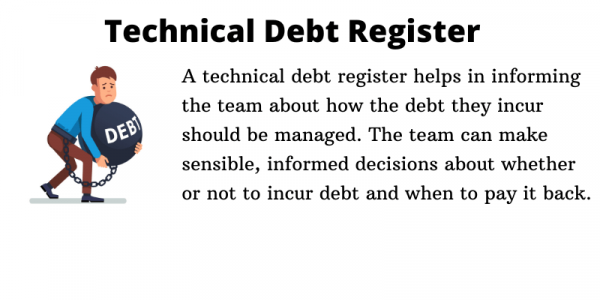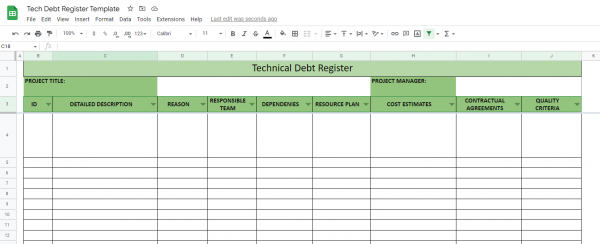Technical debt is anything that slows you down. It extends to all the tools, languages, and frameworks you use for your projects. It can come in many forms, such as lack of a proper interface design or a lack of unit testing. It is essential for tracking and managing these debts.
A technical debt register helps you to identify existing technical flaws, record the time it will take to fix them, and evaluate future feature requirements against future debts that the program may incur. In agile/ scrum terms is known as a velocity issue because it affects the working of your product for the client.
Knowing when and how to manage it can make you the most profitable programmer in your industry. It means avoiding unnecessary defects, speeding up iterations, and improving quality before releasing products. By tracking and managing the debts, you can begin to build a successful corporation with a well-trained team of engineers and developers.
Objectives of the Technical debt register
To keep track of all Debt in a project
The main aim of the technical debt register is to keep track of all debt elements in the project. By doing so, you will make sure that your project stays on track. Each time you log a debt, you must check it against the backlog first to make sure it doesn’t overlap with anything else. You can use your resources efficiently if a new development is done.
Save time and money
Since it affects all aspects of software development, tracking it as soon as possible is essential. Many problems can occur when letting debts slip through your fingers, so it comes down to being responsible for your actions. As a result, you must be sure that you don’t let them go to waste.
Doing this will save time and money because you will know exactly how much it will cost to fix each Debt. You will not make the same mistake twice; this way, you can avoid taking on unnecessary expenses that could pull your project in the wrong direction.
Know when your project is in trouble
It register provides a handy tool to ensure future projects can meet future goals.
Improve quality
You must know the quality of your product or service. You don’t want to be creating destructive code just because you didn’t take the time to manage it. By having this tool, you can assess your project and all its future debts.
Evaluate changes that affect your product
If a new feature is implemented, you will know exactly how much it will affect the overall operation of your development. This way, you can keep track of the processes and fees required to implement it.

Types of Technical Debts
Deliberate technical debt
This type of Debt is usually taken on to reap some benefit. It occurs when you choose not to do something right, so you can do it more accessible and faster. For example, a team may deliberately choose to have poor code documentation to deliver the project on time. You must identify these costs early on.
Accidental technical debt
It happens when a developer makes an error or takes a shortcut. It can be either due to inexperience or a lack of time. For example, if an inexperienced team member has been given a task they have no idea how to do, they would likely take some shortcut. This way, the team can still deliver the project on time and not have to worry about fixing everything later.
The technical debt of opportunity
It is when you take out Debt to seize an opportunity that you are being presented with. For example, you might be allowed to save money or time by implementing a product that’s no longer necessary. You may take on this Debt to do this. It could also be that a team member suggests implementing something new that might not be necessary at all.
How to Document Technical Debt in the Register?
Technical debt is frequently caused by a lack of technical documentation, particularly for infrastructure and project code. Particularly for projects with a limited budget, technical documentation is simple to overlook or undervalue. To document the technical debt follow the steps mentioned below:
Prepare a list of Statements
It’s essential for designers always to have at least one person in the team that does the writing of the debt register. It is because there are times when you need one person or person who has a large amount of experience in programming and design. When you have this person, it’s not just a good idea to prepare a list of statements but rather create the format for them.
Assign Meaning to each statement
It is something that can screw things up for you if you don’t watch over it closely. Since you must be aware of each Debt you have weekly, you must ensure that you don’t let things fall through the cracks. The best way to do this is by assigning meaning to certain statements per the Technical Debt Register template.
Organize the Statements
It would help if you organized your statements to make it easy for anyone to find what they are looking for. You want your team members to be able to find any technology in their project at any given time because this will save them time and money.
Tech Debt Register Template Google Sheets

Make a copy of our tech debt register here.
Other Tools to Manage Technical Debt
JIRA
JIRA is a tremendous Technical debt tool that many programmers like to use because it allows them to see what dependencies are used in their code. It is helpful because if you know what other classes or files you have on your project, you can fix any issues that might be causing problems. JIRA can be used as a simple way to determine the time and effort it will take to fix the specific issues.
GitHub
If you want the ability to assign meaning to your debt statements, then a better option would be GitHub. It is a digital place where you can encourage teamwork and make sure that every member of your team always has access to information.

Examples of technical debt
Poor software code quality
Software codes are so important because this is how all software and programs come to the market. For instance, an application’s principle must be smooth and understandable for the users. It will not significantly affect your project from an operation standpoint if it does not meet these requisites.
Lack of documentation
It is something that must always be considered when you are developing any product or program. When you don’t have this information, it can cause issues such as incomplete information or wasted time. If a developer doesn’t know how to use the code, they will have to waste time and money to find out.
Insufficient software testing
If you are not testing your software, you will not have a good idea of how it works. For instance, if you are not thoroughly trying your software, it could cause problems further down the line. It can also cause issues from an operation standpoint because people don’t know what’s happening when they use it. It can also cause problems for the users and the company itself.
Consequences Of Technical Debt
Reduced Quality
It is not only an issue where you are unable to meet the future needs of your team, but it is also an issue where you will be unable to meet the quality standards there set before. It is because every time a fix is implemented, it has to go through testing, and sometimes, this can take days or weeks if it even works.
Increased Risk
It can also cause an increased risk for future projects. Since there is no natural way to predict what will happen in your project, there are times when it gets worse, causing bugs that are difficult to fix.
Increased Costs
It can also cause increased costs since the load on your staff will be larger than anything they’ve ever had to deal with before. It is because now you need to manage many different issues and ensure everything is on track, so it doesn’t go off course.
Tech Debt FAQs
What is a Technical Debt Register?
It is a document that synchronizes the technical information needed to maintain a software program. It’s essential to create an easy way to find all the news on your project so that you can fix the problems immediately.
How do you Manage Tech Debt in Agile?
It would help if you handled it only when doing a software program or website. Agile is a great way to deal with programming because it helps every team member work together for the entire product to be successful.
How do you categorize technical Debt?
It can be categorized in many ways depending on how the team wants its software to work. The best way is to order them however you choose, but remember that this will dep
